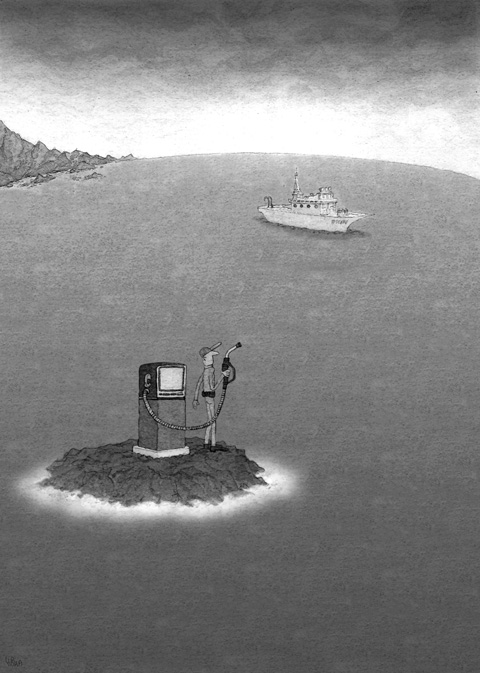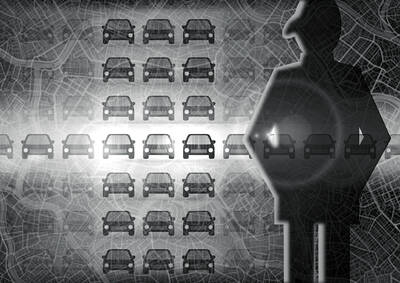The Shinei Maru No. 66 looks like the dozens of other fishing boats moored in this Japanese harbor. But its builders say it is the world’s first hybrid fishing trawler. By switching between oil and electric-powered propulsion, it uses up to a third less fuel than conventional boats.
“It’s like a Prius for the sea,” said Tadatoshi Ikeuchi, 62, the boat’s owner and captain.
Commercial fishermen around the world have been laboring under the weight of high fuel prices. In Europe, they have expressed their frustration by blockading ports to protest the prices and taxes on fuel.

In the US, Alaskan Governor Sarah Palin, the Republican vice presidential nominee, has called for low-interest loans to help Alaskan fishermen buy fuel-efficient engines.
Japan is searching for high-tech solutions to the cost of fuel. In fact, the hybrid boat engine, which is still just a prototype, is part of a multimillion-dollar government-led effort to rescue Japan’s fishing industry from high energy prices.
Fuel costs have risen 40 percent in Japan this year, to about US$1 a liter. As part of the two-year-old program, the Japanese are also testing biofuel-powered marine engines, computer-engineered propeller designs and low-energy LED lights on squid boats, which use bright lights to lure their catch.
There is a vast international market for such solutions. Many Japanese boat engines that use computers to raise fuel efficiency are already popular among American fishermen. And Yamanaka, the Tokyo-based maker of the hybrid engine for the trawler, which is called the Fish Eco, says the US and Europe are large potential markets.
Japan’s agriculture and fisheries ministry, which is leading the aid project, says it will help pay for research, but most of the costs are being borne by the private sector, mainly fishermen’s groups and private companies.
Modernization of this most ancient of enterprises seems the natural answer here to the commercial fishing crisis, which predates the run-up (and recent stabilization) in fuel prices.
Japan gave the world both sushi and the hybrid car. But fishermen say they doubt the effort will be enough to break the deep sense of malaise that has started to afflict fishing communities like Otoshibe in northern Japan.
After decades of sending its fleets to the far corners of the globe, and paying top yen for tuna and other premium fish for sashimi in global markets, Japan’s fishing industry appears to many to be in irreversible decline.
The number of commercial fishermen has shrunk by 27 percent in the last decade, to 204,330 last year, hurt by declining birthrates and migration of young people to the cities, said the National Federation of Fisheries Cooperative Associations, an industry group representing fishermen.
The federation warns that rising fuel costs could force an additional 25,000 to 45,000 fishermen to hang up their nets. Boat fuel, known as heavy oil, now accounts for about 20 percent to 30 percent of a fisherman’s total costs in Japan, almost double its proportion three years ago.
Japan’s fishermen say the cost of fuel, which has tripled in the last three years, puts them in a particular bind. They cannot pass the increase on to consumers in the form of higher seafood prices for fear of losing sales to cheaper imports from Asian competitors such as China and Vietnam.
They also worry that higher seafood prices would only worsen the shift in Japanese consumer tastes away from a traditional seafood-centered diet — known as sakana banare, or flight from fish.
“Higher fish prices will just encourage Japanese to eat more hamburgers and fried chicken,” said Nobuhiro Nagaya, a managing director at the fisheries federation.
US fishermen make similar complaints. They say they cannot raise prices because consumers can easily defect to cheaper chicken, pork and beef.
Nagaya and others here admit their fears may seem overblown to Americans, considering that the average Japanese still eats about 94g of fish a day, five times the amount consumed by the average American.
Still, gloomy sentiment about the future of Japan’s industry are shared by officials at the agriculture and fisheries ministry.
While their multimillion-dollar projects recall the government-orchestrated technology drives of previous decades, when Japan rose to global dominance in industries like semiconductors and supercomputers, officials express far more modest expectations today in an era of tight budgets and limited economic growth.
“Technology cannot be the only answer,” said Kazuo Hiraishi, an assistant chief in the ministry’s maritime technology research division. “But Japan’s excellence in electronics and energy-saving should be of some help to our fishermen.”
This sense of resignation, and wider apathy about the future of the industry, are some of the reasons Japanese fishermen have not taken to the streets with the same fervor as their European counterparts.
While fishermen in countries like France, Spain and Ireland have staged disruptive demonstrations, protests in Japan have been more sedate, though still large. In July, for instance, some 200,000 fishing boats stayed in port on a one-day strike, and thousands of fishermen gathered for a peaceful rally in Tokyo.
The government responded two weeks later with a US$700 million aid package that promised to pay 90 percent of fuel price increases since December, but only to fishermen who found ways to reduce their fuel consumption.
The package also contained subsidies to help fishermen buy efficient new engines, like the hybrid.
A US$250,000 subsidy from the agriculture ministry, for example, meant that Ikeuchi paid only US$650,000 for his hybrid trawler, the same price as a conventional boat.
Ikeuchi said his fuel use had dropped to about 284 liters a day, cutting his daily bill by about US$100. The propulsion system switches between a 650-horsepower heavy oil motor, which powers the main engine, and a 150-horsepower heavy oil motor, which turns a generator that runs a smaller electric engine for use when the boat moves slowly.
On a recent day, Ikeuchi showed off the boat, which he uses to hunt for scallops, Pacific cod and kelp, a delicacy in Japan. The only visible difference with other fishing boats in this small, man-made harbor was its dashboard, which featured small touch-controlled screens — high-tech devices for a craft made mostly of traditional-looking wood and steel.
Still, many fishermen who walked over to take a peek at the boat doubted it would be enough to save their industry.
“Fuel prices are just too high now,” said Kazuo Sawada, 51, a fisherman here. “No one will want to be a fisherman anymore.”
Concerns that the US might abandon Taiwan are often overstated. While US President Donald Trump’s handling of Ukraine raised unease in Taiwan, it is crucial to recognize that Taiwan is not Ukraine. Under Trump, the US views Ukraine largely as a European problem, whereas the Indo-Pacific region remains its primary geopolitical focus. Taipei holds immense strategic value for Washington and is unlikely to be treated as a bargaining chip in US-China relations. Trump’s vision of “making America great again” would be directly undermined by any move to abandon Taiwan. Despite the rhetoric of “America First,” the Trump administration understands the necessity of

US President Donald Trump’s challenge to domestic American economic-political priorities, and abroad to the global balance of power, are not a threat to the security of Taiwan. Trump’s success can go far to contain the real threat — the Chinese Communist Party’s (CCP) surge to hegemony — while offering expanded defensive opportunities for Taiwan. In a stunning affirmation of the CCP policy of “forceful reunification,” an obscene euphemism for the invasion of Taiwan and the destruction of its democracy, on March 13, 2024, the People’s Liberation Army’s (PLA) used Chinese social media platforms to show the first-time linkage of three new

If you had a vision of the future where China did not dominate the global car industry, you can kiss those dreams goodbye. That is because US President Donald Trump’s promised 25 percent tariff on auto imports takes an ax to the only bits of the emerging electric vehicle (EV) supply chain that are not already dominated by Beijing. The biggest losers when the levies take effect this week would be Japan and South Korea. They account for one-third of the cars imported into the US, and as much as two-thirds of those imported from outside North America. (Mexico and Canada, while
I have heard people equate the government’s stance on resisting forced unification with China or the conditional reinstatement of the military court system with the rise of the Nazis before World War II. The comparison is absurd. There is no meaningful parallel between the government and Nazi Germany, nor does such a mindset exist within the general public in Taiwan. It is important to remember that the German public bore some responsibility for the horrors of the Holocaust. Post-World War II Germany’s transitional justice efforts were rooted in a national reckoning and introspection. Many Jews were sent to concentration camps not